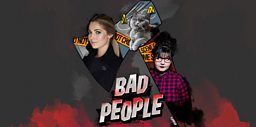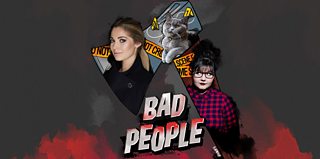Children Who Kill
Written by Dr Julia Shaw

Instead of treating the boys as monsters, they were treated with kindness and sympathy.
Children as perpetrators of horrific acts make us think critically about the assumed innocence and protected status of childhood. We are forced to ask ourselves how and why something terrible could be done by someone so young, and who is to blame – the child, the family, or perhaps even the society they live in?
On episode six of Bad People, Sofie Hagen and I discuss two cases that involve children who have killed other children. We wonder what could drive children to such acts, and whether the societal responses they elicited were appropriate.
We start with a from 1994, where two six year old boys had badly beaten a five year old girl and left her to freeze to death. This horrific act was met with a startling response from the community: within a week, the boys were back in kindergarten. They were given immediate counselling and special supervision.
Instead of treating the boys as monsters, they were treated with kindness and sympathy.
Just a year earlier, in 1993, the UK was shocked to learn that two-year-old James Bulger was brutally killed by two ten-year-old boys. In stark contrast to the Norwegian case, the boys were charged, convicted, and incarcerated – though admittedly, the age difference was a crucial one for the purposes of criminal responsibility, as I discuss below.
The boys were branded ‘evil’, the judge called the killing “”, while Prime Minister John Major gave a speech in response to the murder where he said that “”.
The two responses couldn’t be more different.
Are either of them correct? First, let’s explore whether children can be born ‘evil’, then turn to different legal responses.

Born evil?
There is no evil gene, but research has found that there is a cluster of traits that typically starts in infancy or early childhood and is associated with the most chronic and severe patterns of antisocial behaviour; .

There is no evil gene.
Psychologist don’t call children psychopaths, because personality is not considered to be stable at this age and it’s a damning label. But, callus-unemotional traits are certainly related to the core emotional components of psychopathy – including a lack of empathy, a lack of guilt, and manipulativeness.
If you have ever read or watched by Lionel Shriver, you know what callous-unemotional traits are. In the book, Shriver paints an image of a little boy who scares his mother because he is emotionally shallow and engages in manipulative and destructive behaviour. Tension increases throughout the story as we read about Kevin growing up, and we see these tendencies develop and manifest in various kinds of antisocial behaviour. Things come to a tragic end.
It’s important to note that while this trajectory can happen, tragic endings that involve severely harming or killing others are rare.
Almost all diagnosed adult psychopaths will have exhibited callous-unemotional traits in childhood, but the same is not true the other way around. Most children with such traits grow out of them, and do not become psychopaths or criminals. Environment and socialisation play a key role in how such childhood traits develop over time.
This means that a combination of callous-unemotional traits and emotional, physical or sexual abuse in the home is likely to be a toxic mix. That being said, while this kind of toxic mix makes it more likely that a child will do something that severely harms others, it isn’t necessarily the case.
It’s also worth noting that children generally have worse decision-making skills than adults. This is partly because, according to people like medical researcher : “The frontal lobes, home to key components of the neural circuitry underlying ‘executive functions’ such as planning, working memory, and impulse control, are among the last areas of the brain to mature; they may not be fully developed until halfway through the third decade of life.” In other words, brains aren’t fully grown until our mid 20s.
It should surprise no one that childrens’ brains and minds are not fully formed yet. This is a major reason why most countries have a minimum age of criminal responsibility.
Compared to most adults, children have impaired decision-making, impulse-control, long-term thinking, and may be unable to fully understand the consequences of their actions.
Doli incapax
What age is the right age to hold humans responsible for their actions?

in England and Wales, the age of criminal responsibility remains at 10. Experts have called this “ridiculously young”.
Since 1963, children under the age of 10 have been treated as incapable of being criminally responsible for any acts. Until 1998, this was also assumed for children between10-14, but it could be challenged by proving that the children understood that what they were doing was bad and that they understood the consequences of it.
This assumption was exported throughout the Commonwealth, which means that today a version of it still exists in many countries – it’s known as Doli incapax.
In line with the conviction of the boys who killed James Bulger, in England and Wales, the age of criminal responsibility remains at 10. Experts have called this “”. In no other country in Europe can such young children be prosecuted for an offence, with the age of criminal responsibility set at 15 in Norway, 14 in Germany, 16 in Portugal and 18 in Luxembourg.
In these countries delinquent young people may still be reprimanded and referred to support systems or programmes to help to prevent them from becoming adult offenders, but this is very different from how adults are treated.
This is perhaps a good point to mention that youth contact with the criminal justice system isn’t necessarily bad. If done well, such contact can create pathways for vulnerable young people to access educational programs, support, and other interventions. These can help them overcome antisocial behavior and related issues including substance abuse and homelessness.
England and Wales have certainly not set the lowest age limit in the world.
at all, theoretically allowing a child to be convicted and sentenced at any age. One implication of this is that there is at least one lawyer in the US who .
What do you think? What age is too young? What should we do with children who commit terrible acts?

I think that perhaps instead of age, criminal responsibility could be established with a competency test, in conjunction with the current fitness to plead concept in England and Wales. Fitness to plead is the capacity of a defendant to understand their court proceedings.
Similarly, a test could be constructed to establish whether an individual was able to have criminal intent. This would benefit young people, but also seems more fair for those adults who have a lower cognitive age than their chronological age.
To learn more about the Norwegian and English cases of children who killed, and the fascinating reactions to them, listen to episode six of Bad People on 91�ȱ� Sounds.

Dr Julia Shaw
Dr Julia Shaw is a research associate at University College London and the co-host of the Bad People podcast on 91�ȱ� sounds. She is an expert on criminal psychology, and the author of two international bestsellers “Making Evil: The Science Behind Humanity’s Dark Side” and “The Memory Illusion: Remembering, Forgetting, and the Science of False Memory.
Her website: www.drjuliashaw.com, and twitter @drjuliashaw



